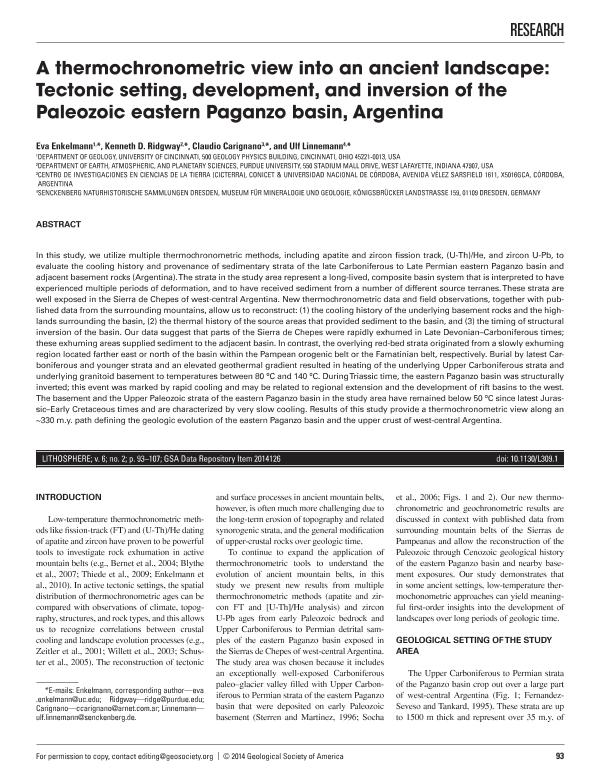Mostrar el registro sencillo del ítem
dc.contributor.author
Enkelmann, Eva
dc.contributor.author
Ridgway, Kenneth D.
dc.contributor.author
Carignano, Claudio Alejandro

dc.contributor.author
Linnemann, Ulf
dc.date.available
2021-06-15T18:33:29Z
dc.date.issued
2014-04
dc.identifier.citation
Enkelmann, Eva; Ridgway, Kenneth D.; Carignano, Claudio Alejandro; Linnemann, Ulf; A thermochronometric view into an ancient landscape: Tectonic setting, development, and inversion of the Paleozoic eastern Paganzo basin, Argentina; Geological Society of America; Lithosphere; 6; 2; 4-2014; 93-107
dc.identifier.issn
1941-8264
dc.identifier.uri
http://hdl.handle.net/11336/133919
dc.description.abstract
In this study, we utilize multiple thermochronometric methods, including apatite and zircon fission track, (U-Th)/He, and zircon U-Pb, to evaluate the cooling history and provenance of sedimentary strata of the late Carboniferous to Late Permian eastern Paganzo basin and adjacent basement rocks (Argentina). The strata in the study area represent a long-lived, composite basin system that is interpreted to have experienced multiple periods of deformation, and to have received sediment from a number of different source terranes. These strata are well exposed in the Sierra de Chepes of west-central Argentina. New thermochronometric data and field observations, together with published data from the surrounding mountains, allow us to reconstruct: (1) the cooling history of the underlying basement rocks and the high-lands surrounding the basin, (2) the thermal history of the source areas that provided sediment to the basin, and (3) the timing of structural inversion of the basin. Our data suggest that parts of the Sierra de Chepes were rapidly exhumed in Late Devonian-Carboniferous times; these exhuming areas supplied sediment to the adjacent basin. In contrast, the overlying red-bed strata originated from a slowly exhuming region located farther east or north of the basin within the Pampean orogenic belt or the Famatinian belt, respectively. Burial by latest Carboniferous and younger strata and an elevated geothermal gradient resulted in heating of the underlying Upper Carboniferous strata and underlying granitoid basement to temperatures between 80 °C and 140 °C. During Triassic time, the eastern Paganzo basin was structurally inverted; this event was marked by rapid cooling and may be related to regional extension and the development of rift basins to the west. The basement and the Upper Paleozoic strata of the eastern Paganzo basin in the study area have remained below 50°C since latest Jurassic-Early Cretaceous times and are characterized by very slow cooling. Results of this study provide a thermochronometric view along an ~330 m.y. path defining the geologic evolution of the eastern Paganzo basin and the upper crust of west-central Argentina. © 2014 Geological Society of America.
dc.format
application/pdf
dc.language.iso
eng
dc.publisher
Geological Society of America
dc.rights
info:eu-repo/semantics/openAccess
dc.rights.uri
https://creativecommons.org/licenses/by/2.5/ar/
dc.subject
Apatite and zircon fission track
dc.subject
Thermochronometric methods
dc.subject
Paganzo Basin
dc.subject.classification
Geología

dc.subject.classification
Ciencias de la Tierra y relacionadas con el Medio Ambiente

dc.subject.classification
CIENCIAS NATURALES Y EXACTAS

dc.title
A thermochronometric view into an ancient landscape: Tectonic setting, development, and inversion of the Paleozoic eastern Paganzo basin, Argentina
dc.type
info:eu-repo/semantics/article
dc.type
info:ar-repo/semantics/artículo
dc.type
info:eu-repo/semantics/publishedVersion
dc.date.updated
2021-04-23T16:44:46Z
dc.identifier.eissn
1947-4253
dc.journal.volume
6
dc.journal.number
2
dc.journal.pagination
93-107
dc.journal.pais
Estados Unidos

dc.description.fil
Fil: Enkelmann, Eva. University of Cincinnati; Estados Unidos
dc.description.fil
Fil: Ridgway, Kenneth D.. Purdue University; Estados Unidos
dc.description.fil
Fil: Carignano, Claudio Alejandro. Consejo Nacional de Investigaciones Científicas y Técnicas. Centro Científico Tecnológico Conicet - Córdoba. Centro de Investigaciones en Ciencias de la Tierra. Universidad Nacional de Córdoba. Facultad de Ciencias Exactas Físicas y Naturales. Centro de Investigaciones en Ciencias de la Tierra; Argentina
dc.description.fil
Fil: Linnemann, Ulf. Senckenberg Gesellschaft Für Naturforschung; Alemania
dc.journal.title
Lithosphere
dc.relation.alternativeid
info:eu-repo/semantics/altIdentifier/url/http://lithosphere.geoscienceworld.org/content/6/2.toc
dc.relation.alternativeid
info:eu-repo/semantics/altIdentifier/doi/http://dx.doi.org/10.1130/L309.1
Archivos asociados
